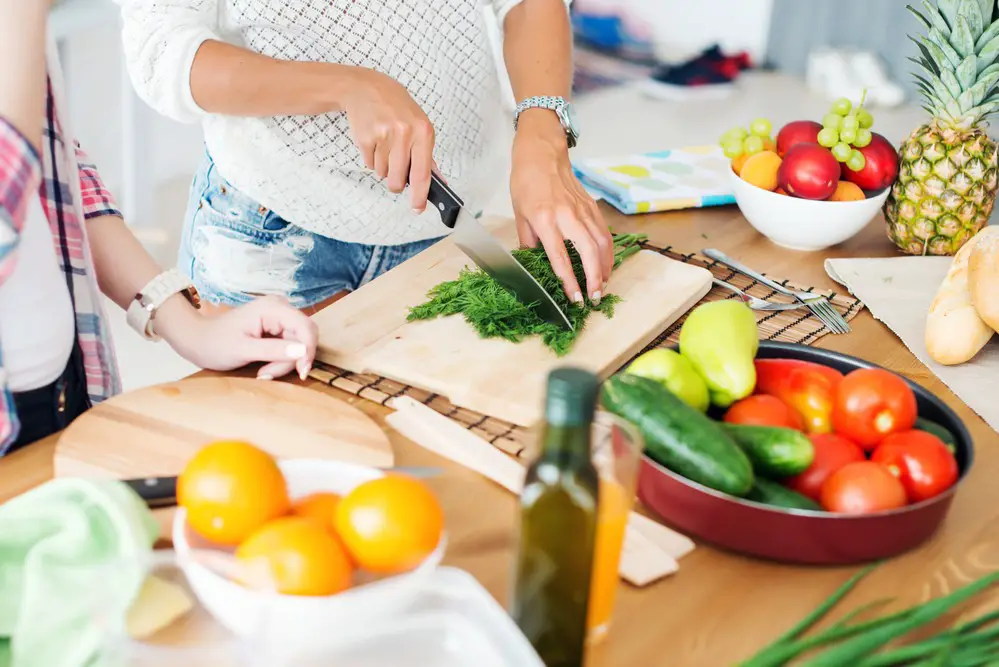To help home cooks elevate their culinary skills, we asked nine professionals in the food industry for their best cooking tips. From embracing the “Mise en Place” approach to prioritizing high-quality, fresh ingredients, here are the top insights shared by our culinary instructors and food bloggers.
- Embrace the “Mise en Place” Approach
- Create Vegetable Stock From Scraps
- Master the Art of Salting
- Respect the “Room Temperature” Rule
- Optimize Cooking With a Thermometer
- Allow Adequate Time for Cooking
- Season Dishes Throughout the Cooking Process
- Adjust Seasonings as You Cook
- Prioritize High-Quality, Fresh Ingredients
 1. Embrace the “Mise en Place” Approach
1. Embrace the “Mise en Place” Approach
Be prepared! In the industry, we call this “mise en place,” meaning having everything in its place. It involves preparing everything in advance or before you cook the dish. Having everything right there and ready is efficient and satisfyingly easy. Mise en place—don’t mess with the mise!
Jack Low, Culinary Instructor
2. Create Vegetable Stock From Scraps
Have a ready supply of vegetable stock made from scraps. The stalks and tough ends of fresh vegetables like greens, broccoli, asparagus, cauliflower, etc., can be saved and frozen. When you have enough, you can cook it up as stock. It can be as easy as adding salt, water, and the cuttings to a pot and simmering for about 20 minutes.
The resulting stock can be frozen in containers of different sizes. The stock can then later be added to soups, beans, pot roast, or any simmered dish, adding free vitamins, minerals, and taste from what you would normally throw away.
Jeff Zeanah, Owner, Zous Chef
3. Master the Art of Salting
The most significant change I ever made in my home cooking was salt. It sounds super basic, but I read an article once that encouraged the reader to not only salt at every step (so important!) but also to stretch the boundaries of how salty you make each dish.
The only way to really learn is to purposefully keep salting a dish, bit by bit, until you *just* over-salt it. My favorite thing to try this with is soup—once you’ve done the job of learning the boundary of what is perfectly salted versus oversalted, you can toss half a large potato in the batch, then bring it to a low simmer and let the potato absorb the excess.
After 15-20 minutes, fish out the potato chunk (or if you want to eat it, I suggest cutting it into cubes before simmering), then adjust the seasoning again as needed. Your palate should remember what perfectly salty tastes like!
From there, play with different types of salt and even introduce salt to your favorite desserts. You’ll be amazed at the difference!
Ashley Schuering, Food Blogger, Freelance Writer, Confessions of a Grocery Addict
4. Respect the “Room Temperature” Rule
The one tip I can provide is that when a recipe calls for “room temperature” ingredients, plan early and ensure your temperature is in the average room temperature range of 68-76F. This is common in baking for eggs and butter and will produce better cakes and pastries. Patience will result in a better quality product.
Angela Wilson, Chef Instructor, Delagdo Community College
5. Optimize Cooking With a Thermometer
For meats, it ensures they’re cooked to a safe temperature without being overdone. For baked goods like bread or cakes, it can help confirm they’re fully baked inside.
By mastering a thermometer, you can achieve consistent results and optimize the flavor and texture of your dishes. This is the most frequently used kitchen gadget in my arsenal and takes cooking to a whole new level.
Alex Bayev, Chef and Founder, BayevsKitchen
6. Allow Adequate Time for Cooking
The best thing you can do to improve your cooking is to give yourself adequate time to prepare a dish. In the world of “quick recipes” and “30-minute meals,” it’s easy to forget that good food takes time and care to prepare.
Let the sauce simmer for a few extra minutes so the flavors deepen, and allow the veggies to cook a little longer so they caramelize. And whatever you do, don’t raise the heat to speed things up—this will only get you dry, overcooked food.
Casandra Carrick, Food Blogger, Looks Delic
7. Season Dishes Throughout the Cooking Process
As someone who loves to cook, I’ve learned that adding seasonings to food properly throughout the cooking process is the best way to make the tastes stand out.
This personalized method makes the final taste more profound and complex. When we get together to cook, we often use this method, carefully adding small amounts of salt and seasonings that go well with it as we build our meals.
I add a pinch of salt to the onions before sautéing them for a sauce. This draws out their natural moisture and makes them taste sweeter. As the meal progresses, we add herbs and spices that make it more complex.
A final change to the seasonings right before serving ensures a smooth and well-balanced taste. From what I’ve learned and experienced, this method allows flavors to blend and intensify, leading to more delicious and satisfying food.
Matthew Appleton, E-Commerce Manager, Appleton Sweets
8. Adjust Seasonings as You Cook
One cooking tip I can share is always to spice up your dishes. I believe in tasting and adjusting the seasoning as I cook, not just waiting until the end. I can gauge which flavors need a boost by tasting throughout the cooking process.
In my experience, a dish truly shines when it’s seasoned just right from the beginning. I always add spices, herbs, and salt early on, letting them meld with the ingredients as they cook.
Later, I taste what I’ve made and tweak the flavors if needed. If I find my dish a bit plain, I often add a pinch of salt and a splash of acid, like lemon juice or vinegar. This combo can make the other flavors pop.
Tim Sutton, Director, Coffee Geek
9. Prioritize High-Quality, Fresh Ingredients
One cooking tip I learned while traveling to Italy (I am addicted to traveling!) was the importance of using high-quality, fresh ingredients.
In Italy, it was discovered that even the simplest dishes, like pasta with tomato sauce, could be incredibly flavorful when made with the freshest ingredients. The ripest, locally-grown tomatoes, fragrant basil, and high-quality olive oil made a difference.
It’s easy to use this for home cooking, but it might cost a little more, and there might be a need to be more specific about the ingredients to look for. Home cooks should prioritize using fresh, seasonal produce and sourcing ingredients from local markets or trusted suppliers.
This can elevate the flavor of their dishes and make them taste as if they were prepared in the heart of Italy or any other food-centric destination.
Bryan Mullennix, Owner, FeelingVegas

Quick Recap and Some Extra Thoughts:
- Mise en Place: It’s like setting the stage before the performance. Your culinary act flows smoother with less stress.
- Vegetable Stock from Scraps: A creative, eco-friendly way to boost flavors. Your soup pot will love you for this.
- Art of Salting: It’s not just about adding flavor but mastering it. A little practice can lead to big taste dividends.
- Room Temperature Rule: Taking the time to get your ingredients to room temperature can be a game-changer, especially in baking.
- Cooking with a Thermometer: A small investment in a good thermometer could save you from the disappointment of a ruined roast.
- Adequate Time for Cooking: Slow and steady can win the culinary race. Don’t rush art!
- Season Throughout: Think of it as building layers in a painting; each layer adds depth and complexity.
- Adjust Seasonings: Flexibility is key. Be ready to adjust as you go along.
- High-Quality Ingredients: The better the raw materials, the less you must do to make them shine.
Bonus Tips:
- Fresh Herbs over Dried: If you can, always opt for fresh herbs; they provide a flavor that dried ones can’t match.
- Rest Your Meat: After grilling or roasting meat, rest for a few minutes. It helps the juices redistribute, making your meat juicy and flavorful.
- Taste and Smell Spices: Always smell your spices before adding them. They won’t contribute much to your dish if they’ve lost their aroma.
- Invest in Good Kitchen Tools: A good knife, a sturdy cutting board, and quality pots and pans can make cooking much more enjoyable.
Armed with these professional tips and a dash of creativity, you’re on your way to turning everyday meals into extraordinary experiences. Happy cooking!

